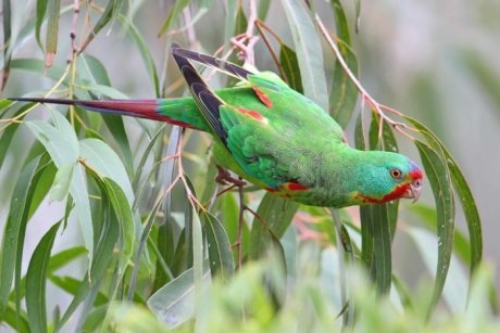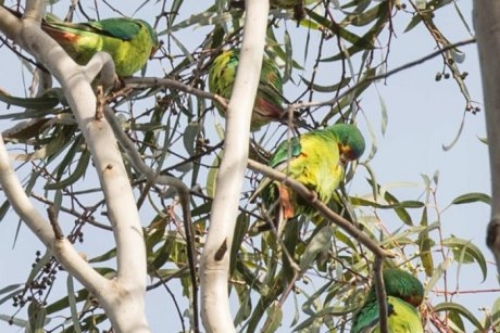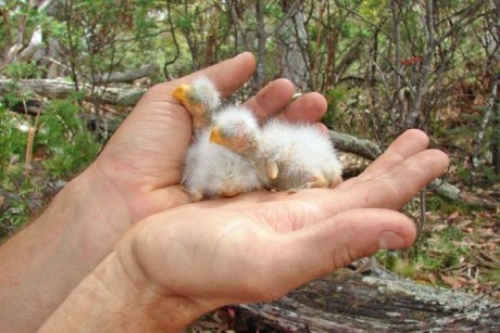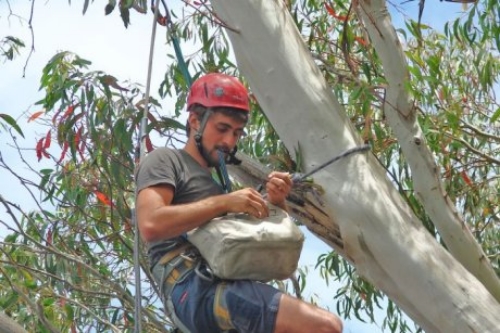 The swift parrot breeds in Tasmania and migrates north to south eastern Australia from Griffith-Warialda in New South Wales and west to Adelaide in the winter. Image by CHRIS TZAROS
The swift parrot breeds in Tasmania and migrates north to south eastern Australia from Griffith-Warialda in New South Wales and west to Adelaide in the winter. Image by CHRIS TZAROS
Forestry Tasmania is being urged to stop logging in 3 per cent of its native forest logging area because it is habitat for the endangered swift parrot.
Analysis by the Wilderness Society used publicly available information to plot the location of important habitat in state forest areas.
 A group of up to 35 endangered swift parrots were seen at La Trobe University, at Macleod, Victoria on June 23, 2015. Image by TESS FLYNN, LA TROBE UNIVERSITYIt argues if Forestry Tasmania fully implemented the Threatened Fauna Adviser protections developed by the Forest Practices Authority, it would impact less than 0.1 per cent of forest production and could help save the parrot.
A group of up to 35 endangered swift parrots were seen at La Trobe University, at Macleod, Victoria on June 23, 2015. Image by TESS FLYNN, LA TROBE UNIVERSITYIt argues if Forestry Tasmania fully implemented the Threatened Fauna Adviser protections developed by the Forest Practices Authority, it would impact less than 0.1 per cent of forest production and could help save the parrot.
They say the swift parrot population will drop by 80 per cent within three generations because of logging and predation by the introduced sugar glider.
Campaign manager Warwick Jordan said over the next three years of Forestry Tasmania's production plan it will log about 1,000 hectares of swift parrot habitat.
"The latest information shows the swift parrot is headed for extinction," he said.
"There's around 2,000 swift parrots left.
"It's got to the point where any areas of habitat that contain mature forest and are the type of forest that swift parrots nest in are important for the species."
Mr Jordan said the latest research showed ongoing logging in areas where the parrot lives is impacting the availability of homes and breeding areas for the swift parrot.
He said 43 of the 681 Forestry Tasmania native forest logging coupes would be impacted if all swift parrot habitat was granted a reprieve from logging.
"What our modelling has shown is that you'd be looking at excluding from harvesting around 3 per cent of the total area that Forestry Tasmania manages for logging," he said.
He said by only adopting the changes prescribed by experts and the Forest Practices Authority the impact on the company would be even less.
"You'd be looking at impacting around 0.1 per cent of Forestry Tasmania's production area over the next three years under existing prescriptions," he said.
A Forestry Tasmania spokeswoman said the company has not seen the report and could not comment on its specifics.
"Forestry Tasmania has not seen the report so we are unable to comment on its specifics but we have requested a briefing from the Wilderness Society."
"Forestry Tasmania is also working with DPIPWE to develop and agree future management arrangements for the swift parrot within the Permanent Timber Production Zone.
"Where issues have been raised around specific coupes, Forestry Tasmania has worked with the Forest Practices Authority to arrive at an outcome that provides protection at the landscape level for potential foraging and nesting habitat for the swift parrot, with significant areas identified as potential swift parrot nesting and foraging habitat excluded from harvesting."
Mr Jordan said the report found there were hotspot areas that needed to be addressed urgently.
"Areas like Bruny Island and the Franklin Forest and the southern forests are particularly important," he said.
"Just 500 hectares of habitat on South Bruny would need to be excluded from logging, less than 0.1 per cent of FT's production forest.
"What we can see at the moment is that Forestry Tasmania are trying to walk quite a tightrope around the impacts of logging on both species like the swift parrot and the balance they're trying to strike to improve their operations and secure FSC certification."
Swift parrot nominated for critically endangered status
 It's estimated there are only 1200 breeding pairs of swift parrots left in Australia. Image by FIONA BLACKWOOD
It's estimated there are only 1200 breeding pairs of swift parrots left in Australia. Image by FIONA BLACKWOOD
Dejan Stejanovic, post-doctoral fellow at the Senner School of Environment and Society, has nominated the swift parrot to be listed as critically endangered.
He said he and a group of scientists pooled five years' worth of data on the swift parrot and its survival.
"The models showed that in every scenario that we tested, swift parrots were on a trajectory towards extinction within three generations," he said.
"The criteria for listing as critically endangered, according to the international body that decides levels of endangerment, is that you have to decline by more than 80 per cent of the population size within three generations.
 ANU researcher Dejan Stojanovic fitting tracking devices to adult swift parrots to see how wide they range for food. Image by FIONA, BLACKWOOD
ANU researcher Dejan Stojanovic fitting tracking devices to adult swift parrots to see how wide they range for food. Image by FIONA, BLACKWOOD
"In the worst-case scenario of the models that we tested, 95 per cent of the population could disappear in sixteen years."
He said legislation should reflect that level of endangerment which is why the formal nomination has been made.
"Critical endangerment means what the animals are using now has an even greater level of importance," he said.
"And the point of nominating them was to increase the recognition of the importance of the existing habitat."
The swift parrot nomination has been included on the Federal Government's Finalised Priority Assessment List.
The Federal Scientific Committee will make a full assessment of the nomination by September 2016.